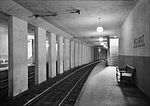Vestre gravlund
1902 establishments in NorwayBuildings and structures in OsloBurials at Vestre gravlundCemeteries in NorwayCemeteries in Oslo ... and 2 more
Commonwealth War Graves Commission cemeteries in NorwayLutheran cemeteries

Vestre Gravlund is a cemetery in the Frogner borough of Oslo, Norway. It is located next to the Borgen metro station. At 60 acres (0.24 km2), it is the largest cemetery in Norway. It was inaugurated in September 1902 and also contains a crematorium (Vestre krematorium) and chapel (Gravkapellet).The grave chapel was constructed in granite and clay stone and was designed by architect Alfred Christian Dahl (1857–1940). It was built in 1900 and consecrated in 1902. In the foundation wall, it has stained glass that was designed by artist Oddmund Kristiansen (1920–1997) in 1970.
Excerpt from the Wikipedia article Vestre gravlund (License: CC BY-SA 3.0, Authors, Images).Vestre gravlund
Monolitveien, Oslo Ullern
Geographical coordinates (GPS) Address Nearby Places Show on map
Geographical coordinates (GPS)
| Latitude | Longitude |
|---|---|
| N 59.931666666667 ° | E 10.697222222222 ° |
Address
Vestre gravlunds kapell
Monolitveien
0274 Oslo, Ullern
Norway
Open on Google Maps









